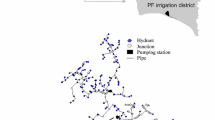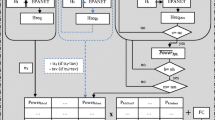Abstract
Pressurized irrigation networks and organized on-demand are usually constrained by the high amounts of energy required for their operation. In this line, sectoring, where farmers are organized in turns, is one of the most efficient measures to reduce their energy consumption. In this work, a methodology for optimal sectoring is developed. Initially it groups similar hydrants in homogeneous groups according to the distance to the pumping station and their elevation, using cluster analysis techniques and certain dimensionless coordinates. Second, an algorithm based on the EPANET engine is implemented to search for the best monthly sectoring strategy that accomplish supplying the actual irrigation demand under minimum energy consumption conditions. This methodology is applied to two Spanish irrigation districts (Fuente Palmera and El Villar). Results showed that organizing the networks in sectors, annual energy savings of 8 and 5% were achieved for Fuente Palmera and El Villar when the theoretic irrigation needs were considered. However, these savings rose up to 27 and 9%, respectively when the local practices, deficit irrigation, were taken into account. Thus, they confirm that water and energy efficiency cannot be optimized independently and need to be considered together.








Similar content being viewed by others
Abbreviations
- α:
-
Excess of pressure in the worst open hydrant
- D:
-
Number of working hours
- E:
-
Daily energy consumption
- F mjl :
-
Demanded flow in month m, sectoring option j and operating sector l
- H max :
-
Maximum theoretic pressure head
- H pmjl :
-
Pressure head at the pumping station in month m, sectoring option j and operating sector l
- H ei :
-
Elevation from the water source to the hydrant i
- H i :
-
Energy required to supply water to the hydrant i
- H j :
-
Pressure in the worst open hydrant
- H li :
-
Friction losses in pipes
- H reqi :
-
Required pressure head at hydrant
- INim :
-
Daily irrigation need
- l i :
-
Distance from the pumping station to the hydrant i
- l max :
-
Distant to the furthest hydrant
- l i *:
-
Dimensionless coordinate for sectoring
- p imj :
-
Probability of open hydrant in month m and sectoring option j
- Power:
-
Power requirements at the pumping station
- q i :
-
Base demand in hydrant i
- q maxi :
-
Maximum flow allowed per hydrant
- R imjl :
-
Random number based on the (0, 1) uniform distribution
- t aj :
-
Number of hours available for irrigation in sectoring option j
- t im :
-
Number of hours needed to irrigate for every hydrant (i) and every month (m)
- γ:
-
Water specific weight
- η:
-
Pumping system efficiency
- z i :
-
Elevation of hydrant i
- z ps :
-
Elevation of the pumping station
- z i *:
-
Dimensionless coordinate for sectoring
References
Abadia R, Rocamora C, Ruiz A, Puerto H (2008) Energy efficiency in irrigation distribution networks I: theory. Biosyst Eng 101:21–27
Allen RG, Pereira LS, Raes D, Smith M (1998) Crop evapotranspiration: guidelines for computing crop water requirements. FAO Irrigation and Drainage Paper No. 56. Rome, Italy
Blanco M (2009) Análisis de la eficiencia energética en el uso del agua de riego. Graduation thesis, University of Córdoba. Spain
Carrillo MT (2009) Uso racional del agua y la energía en la comunidad de regantes de FP. Graduation thesis, University of Cordoba, Spain
Clarke D (1998) CropWat for windows : user guide. FAO, Italy
Clément R (1966) Calcul des débits dans les réseaux d’irrigation fonctionant a la demande. La Houille Blanche, No. 5
Corominas J (2009) Agua y energía en el riego en la época de la sostenibilidad. Jornadas de Ingeniería del Agua 2009. Madrid, Spain
Daccache A, Lamaddalena N, Fratino U (2010) On-demand pressurized water distribution system impacts on sprinkler network design and performance. J Irrig Drain Eng 136(4):261–270
Holden NM, Brereton AJ (2004) Definition of agroclimatic regions in Ireland using hydro-thermal and crop yield data. Agric For Meteorol 122:175–191
IDAE (2008) Ahorro y Eficiencia Energética en las Comunidades de Regantes. Ministerio de Industria, Turismo y Comercio
ITRC (2005) CEC agricultural peak load reduction program. California Energy Commission, USA
Jain AK (2000) Statistical pattern recognition: a review. IEEE Trans Pattern Anal Mach Intell 22:4–38
Jiménez Bello MA, Martínez Alzamora F, Bou Soler V, Bartolí Ayala HJ (2010) Methodology for grouping intakes of pressurised irrigation networks into sectors to minimise energy consumption. Biosyst Eng 105:429–438
Lamaddalena N, Fratino U, Daccache A (2007) On-farm sprinkler irrigation performance as affected by the distribution system. Biosyst Eng 96(1):99–109
MAPA (2001) Plan Nacional de Regadíos. Horizonte 2008. Madrid, Spain
Moreno MA, Carrión PA, Planells P, Ortega JF, Tarjuelo JM (2007) Measurement and improvement of the energy efficiency at pumping stations. Biosyst Eng 98:479–486
Moreno MA, Planells P, Córcoles JL, Tarjuelo JM, Carrión PA (2009) Development of a new methodology to obtain the characteristic pump curves that minimize the total costs at pumping stations. Biosyst Eng 102:95–105
Pérez Urrestarazu L, Rodríguez Díaz JA, Camacho Poyato E, López Luque R (2009) Quality of service in irrigation distribution networks. The case of Palos de la Frontera irrigation district (Spain). J Irrig Drain 135(6):755–762
Plusquellec H (2009) Modernization of large-scale irrigation systems: is it an achievable objective or a lost cause? Irrig Drain 58:104–120
Pulido-Calvo I, Roldan J, López-Luque R, Gutiérrez-Estrada JC (2003) Water delivery system planning considering irrigation simultaneity. J Irrig Drain Eng 129(4):247–255
Rodríguez Díaz JA, Camacho E, López R (2004) Application of data envelopment analysis to studies of irrigation efficiency in Andalucia. J Irrig Drain Eng 130:175–183 (American Society of Civil Engineers)
Rodríguez Díaz JA, Camacho Poyato E, López Luque R (2007a) Model to forecast maximum flows in on-demand irrigation distribution networks. J Irrig Drain Eng 133(3):222–231
Rodríguez Díaz JA, Weatherhead EK, Knox JW, Camacho E (2007b) Climate change impacts on irrigation water requirements in the Guadalquivir River Basin in Spain. Reg Environ Change 7:149–159
Rodríguez Díaz JA, Camacho Poyato E, López Luque R, Pérez Urrestarazu L (2008) Benchmarking and multivariate data analysis techniques for improving the efficiency of irrigation districts: an application in Spain. Agric Syst 96:250–259
Rodríguez Díaz JA, López Luque R, Carrillo Cobo MT, Montesinos P, Camacho Poyato E (2009) Exploring energy saving scenarios for on-demand pressurised irrigation networks. Biosyst Eng 104:552–561
Rossman LA (2000) EPANET 2. Users manual. US Environmental Protection Agency (EPA), USA
Sánchez R, Laguna F V, Juana L, Losada A, Castañón G, Rodríguez L, Gil M (2009) Organización de turnos para la optimización energética de redes colectivas de riego a presión. Jornadas de Ingeniería del Agua 2009. Agua y Energía. Madrid, Spain
Vieira F, Ramos HM (2009) Optimization of operational planning for wind/hydro hybrid water supply systems. Renew Energy 34:928–936
Author information
Authors and Affiliations
Corresponding author
Additional information
Communicated by J. Kijne.
Rights and permissions
About this article
Cite this article
Carrillo Cobo, M.T., Rodríguez Díaz, J.A., Montesinos, P. et al. Low energy consumption seasonal calendar for sectoring operation in pressurized irrigation networks. Irrig Sci 29, 157–169 (2011). https://doi.org/10.1007/s00271-010-0228-2
Received:
Accepted:
Published:
Issue Date:
DOI: https://doi.org/10.1007/s00271-010-0228-2




